I prepare a Whole Roasted Chicken most Sunday afternoons. It’s a classic comforting recipe that has the added benefits of being both nutritious and cheap. I stretch it into at least two meals and as many lunches to get the most bang for the buck. A roasted chicken in a cast iron pan ensures super crispy skin and tender meat.
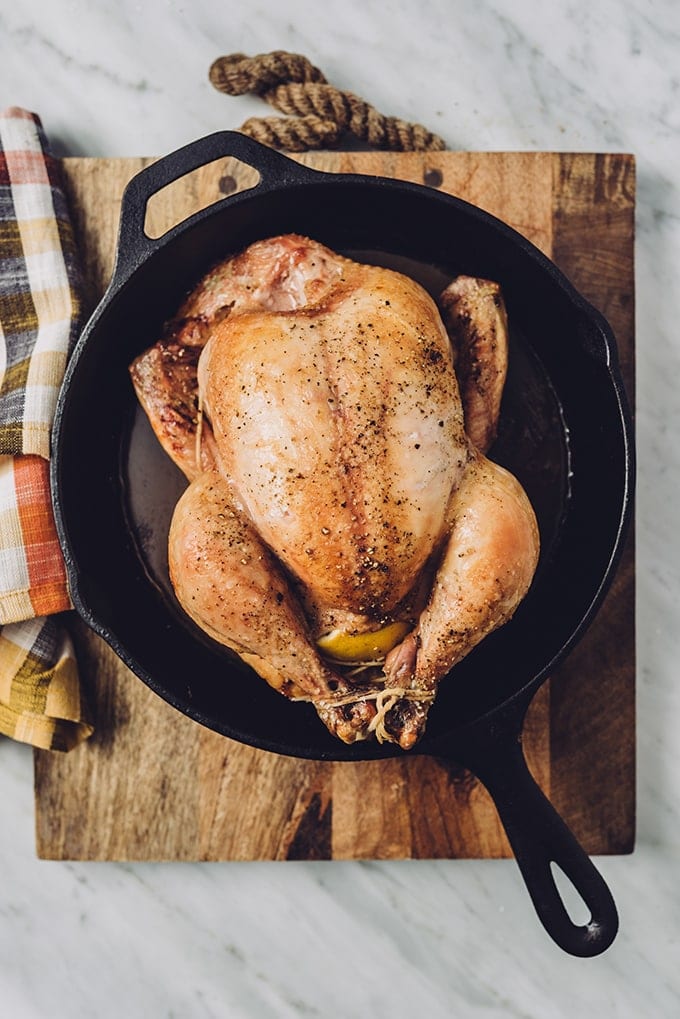
Five or six years ago amid a google firestorm, I stumbled into the world of locally grown, pasture-raised chickens. I had been an organic-eating semi-locavore for several years, but I was still largely sourcing my meat from the chain grocery store. Partially for the convenience, but largely for the price. A whole pastured chicken ’round these parts can run anywhere from $15-$25 depending on the size, season, and where you’re sourcing it from. That’s a lot of bucks for a bird.
I’m not going to go into why I now exclusively purchase locally pastured chickens (it’s a post for another day, and it’s definitely coming, but it requires more brain cells than I can rub together at the moment), but this week I’m going to share how I use every last bit of a whole bird to maximize every penny spent. Hint: it’s not rocket science.
Typically I start with my favorite meal ever – a whole roasted chicken. I roast a whole chicken at least every two weeks, sometimes weekly, always on Sundays. It’s a nostalgic-laden, satisfying meal that every beating heart in this house never tires of. It’s easy peasy lemon squeezy, and one of the first meals I suggest when anyone asks me where to start with scratch home cooking.
A roasted chicken is adaptable to any season because the sides are basically whatever you want that’s in-season. Everything goes with chicken, amirite? In the winter I reach for roasted potatoes and root vegetable purees, pan-seared brussels sprouts, and occasionally a mushroom pan gravy. As spring moves in we transition to asparagus, minty snap peas, and quinoa or brown rice, and in the summer you’ll see me serving it with tomato-peach salad, gazpacho, and fresh roasted corn salad.
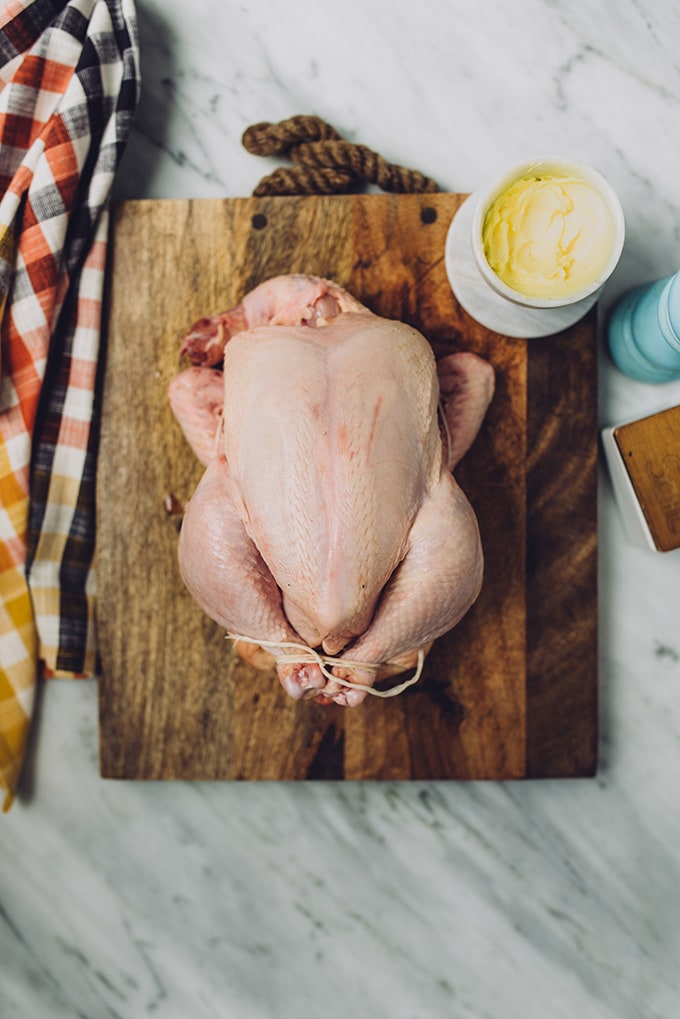
We usually stuff our faces with about ½ of the bird at Sunday dinner. Cameron likes the leg/thigh, and the Big Kid and I usually share a breast. The other half gets picked off the bones and tucked into the fridge for a second meal, and occasionally a third, depending on the dish and how much meat I have leftover.
Then I toss the carcass into the slow cooker and make a long-simmered bone broth that yields at least three quarts of rich broth. I use the broth for any number of things, but mostly for soups or stews that rely on the flavor profile of the broth to enhance the taste of the dish. If it’s a bigger bird (closer to 5 pounds that 4), I’ll simmer it a second time in half the amount of water to yield another quart to quart-and-a-half of a lighter, but still tasty, broth; I use this broth for things like cooking quinoa and rice to impart a little extra flavor.
Recipes Notes for Cooking a Whole Chicken in a Cast Iron Skillet
There are more ways to cook a chicken than there are to skin a cat and I’ve tried them all. My favorite method is roasting in a cast iron pan. The skin gets super crispy all over and clean-up is a breeze because you can make a pan gravy right in the skillet. Less dishes to clean is always a win in my book, and crispy skin? ‘Nuff said.
I’ve cooked many a bird over the years, and here are my best tips for a perfect roasted chicken:
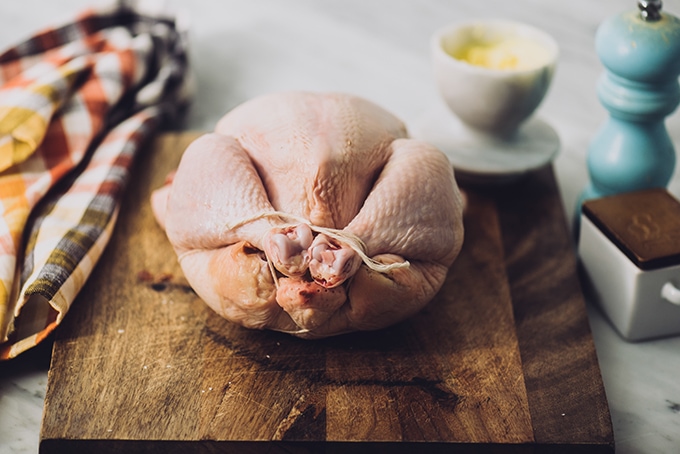
- Ingredients. Chicken, butter, salt and pepper. A lemon if you’re feeling fancy. That’s it. As with all cooking, you get what you pay for. Buy the best ingredients you can afford. Aim for local pastured chicken; grass fed butter and high-quality sea salt are essential. I rub the bird down with a generous handful of butter (at least 2 tablespoons) and then sprinkle with lots of sea salt and cracked black pepper. If you’re feeling fancy you can stuff the cavity with a quartered lemon and some fresh herbs.
- Trussing. Trussing is essential and easier than it looks. Trussing allows the meat to cook evenly and prevents the breast meat from getting too dry before the dark meat fully cooks.
- Pre-Cook Rest n’ Salt (AKA Dry Brining). Before I cook my bird, I bring her to room temperature. First I dry the bird completely with paper towels and then rub with a tablespoon of sea salt. Then I walk away for an hour. This is basically the cheater’s method for brining a chicken, sans the water and fuss. The salt draws out some of the moisture in the skin, allowing the skin to crisp up properly, and bringing the meat to room temperature helps with more even cooking.
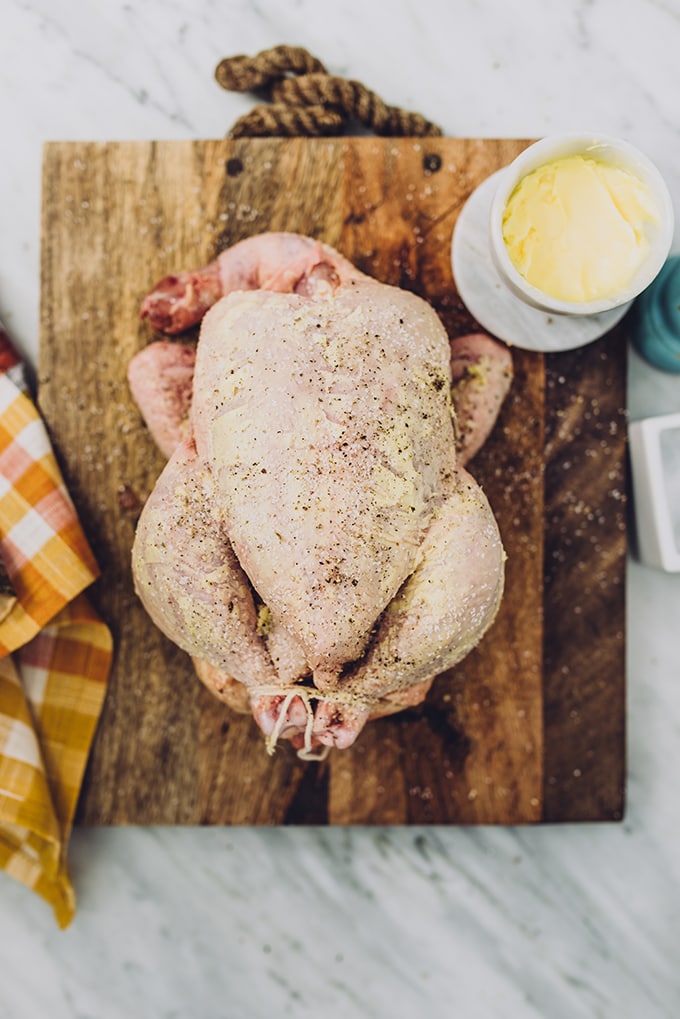
- Slow(ish) Roasting. Roasting time really depends on the size of your bird. I always start the roasting process in a hot 450°F oven, roast for 20 minutes, then reduce to the heat to 325°F and continue roasting until the meat reaches 160°F on an instant read thermometer. 325°F is a touch lower than most recipes and therefore it will take a bit longer to reach temp (60-90 minutes, depending on size). I roast at a lower temperature for pastured chickens because their meat is just a little tougher than standard grocery store birds. This tenderizes the meat and keeps is moist and tasty.
- Post-Roast Rest. Once your chicken is to temp, pull it from the over, transfer to a cutting board and let it rest for 20 minutes while you make your pan gravy. Resting lets the juices settle into the meat, keeping the flavor and tenderness on point.
What to Make with Leftover Cast Iron Skillet Chicken
The leftovers don’t last long in this house, and I usually like to stretch them into another meal. Here are some of my favorite recipes for using shredded chicken:
- Apple Chicken Salad
- Buffalo Chicken Lettuce Wraps
- Pumpkin Chicken Chili
- Healthy Chicken Salad with Almond Butter Dressing
- Turmeric Chicken Soup
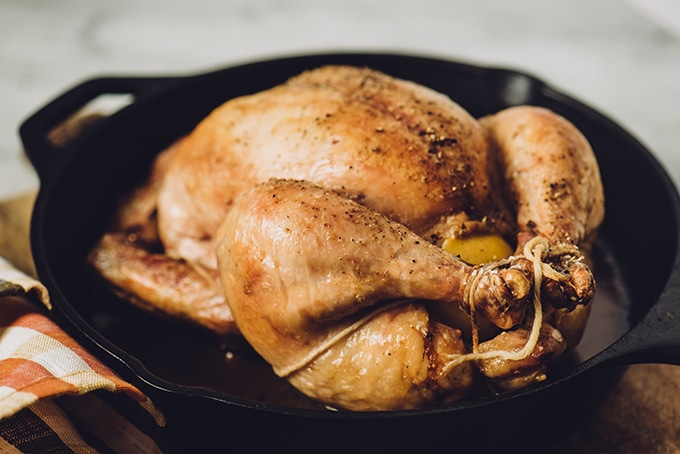
Did you make this Roasted Chicken? I’d love to know how it turned out! Leave a comment and a rating below.
While you’re at it, let’s be friends – follow me on Pinterest and Instagram for the latest and greatest.
Recipe
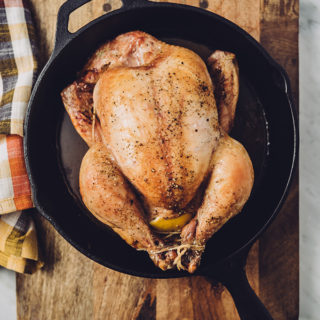
Cast Iron Skillet Whole Roasted Chicken
Print Recipe Rate this Recipe Pin RecipeRecommended Equipment
- Cast Iron Skillet
- Cotton Kitchen Twine
Ingredients
Whole Roasted Chicken
- 1 4-5 lb. whole chicken, pastured when possible
- 1-2 tablespoon sea salt
- 2-3 tablespoon butter, softened
Pan Gravy
- 2 tablespoon butter
- 2 tablespoon all-purpose flour, or cornstarch for gluten free
- ½ c. dry white wine
- 2 c. chicken bone broth or stock
- 1-2 tablespoon heavy cream, optional
- fresh cracked pepper
Instructions
Whole Roasted Chicken
- Truss your chicken, then place in a cast iron pan breast-side up. Sprinkle all over with 1 tablespoon seat salt and allow the chicken to come to room temperature.
- Preheat the oven to 450. Rub the chicken all over with 2-3 tablespoon butter and dust with additional sea salt.
- Roast for 20 minutes at 450, then reduce the oven temperature to 325 and roast until an instant read thermometer reads 160 when inserted into the thigh, 60 -90 minutes more depending on the size of the chicken.
- Move the chicken to a cutting board, reserving the pan drippings, tent loosely with foil and allow to rest at least 15 minutes, and up to 30.
Pan Gravy
- Pour out all but 2 tablespoon – ¼ c. pan juices from the cast iron and heat over medium. Add the butter and heat until it melts. Add the flour and whisk continually until smooth and thickened and the color is a deep golden brown.
- Deglaze with white wine, scraping up the browned bits from the bottom of the pan. Add the broth/stock and simmer 4-5 minutes until the sauce is thick. Add a tablespoon or two of cream if desired and cracked black pepper to taste. Taste for seasoning and adjust as needed.


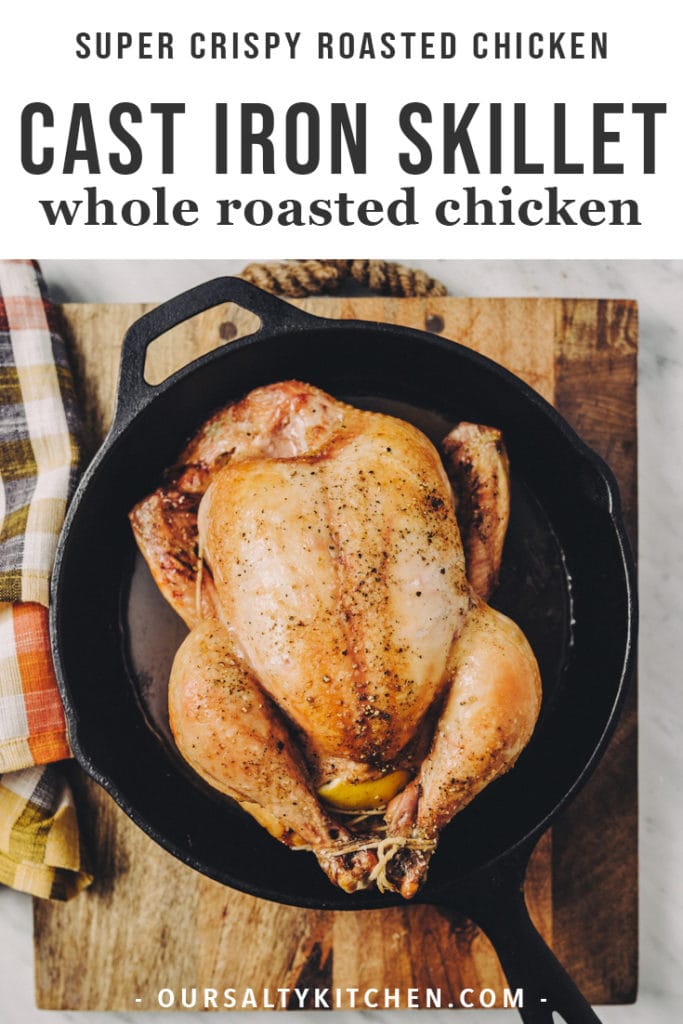

Sandra
This was easy and so delicious.
Danielle
So glad you enjoyed it – thanks for sharing your feedback Sandra!
Terry
I made this type and it turned out GREAT! My family just loved it. The chicken was so tender! It was super!
alma
Super easy and delicious recipe. Everyone in my house loved.
Chloe
I have been coming back to this recipe for a few years and every single time it has turned out fantastic, like husband-can’t stop-picking-at-the-roast delicious. I always use a big, free range, organic bird and this technique gets it fully cooked, tender, but still crispy each time! Even when I don’t dry brine (I always try to since it makes the flavor and texture 1000% more scrumptious) the skin still turns out lovely.
About a quarter of the time I will whip this up for a spectacular chicken soup (I add it at the end so it doesn’t dry out) and use the drippings in the stock, which is most likely bone broth made from the previous bird. I prefer using this roasting method for my soups since roasting it gives it that WOW flavor instead of just boiling chicken in the stock.
From a gal who was just starting off cooking and luckily found this awesome recipe,
Thank you so much. My family will never know a bad roasted chicken!!